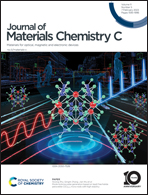Non-rare-earth-doped submicron-grade narrow-band red phosphors for W-LED as well as FED and enhanced Bi3+-doped blue light absorption†
Abstract
A submicron narrow-band red phosphor SrGe4O9:xBi3+,yMn4+ (SGO:BM) was prepared through the co-precipitation method in this study. Under UV excitation, the Mn4+-doped sample has a narrow-band emission spectrum with an emission spectrum half-width of about 19 nm, laying the foundation for future applications in micro-LEDs. A new strategy is proposed to adjust the optimal excitation peak from the UV region (288 nm) to the blue region (425 nm). The principle of this new strategy is attributed to crystal vibrations, symmetry perturbations, and Bi3+ doping of crystal defects. Subsequently, the cathodoluminescence spectra show that the sample had a high saturation current and excellent anti-aging performance under high-energy electron bombardment. Compared with the commercial FED red phosphor Y2O3:Eu3+, the submicron phosphor (1–3 μm) is more suitable for matching the FED screen. Employing a blue chip, yellow phosphors Y3Al5O12:Ce3+(YAG:Ce3+) and SGO:BM were used to fabricate white-light emitting diodes (W-LEDs), which can produce strong warm white light W-LED with high Ra (90.2) and low CCT (4676) at 350 mA forward bias current. Based on its excellent luminescent performances, the SGO:BM phosphor has a broad application prospect in the fields of W-LEDs and FEDs.



 Please wait while we load your content...
Please wait while we load your content...